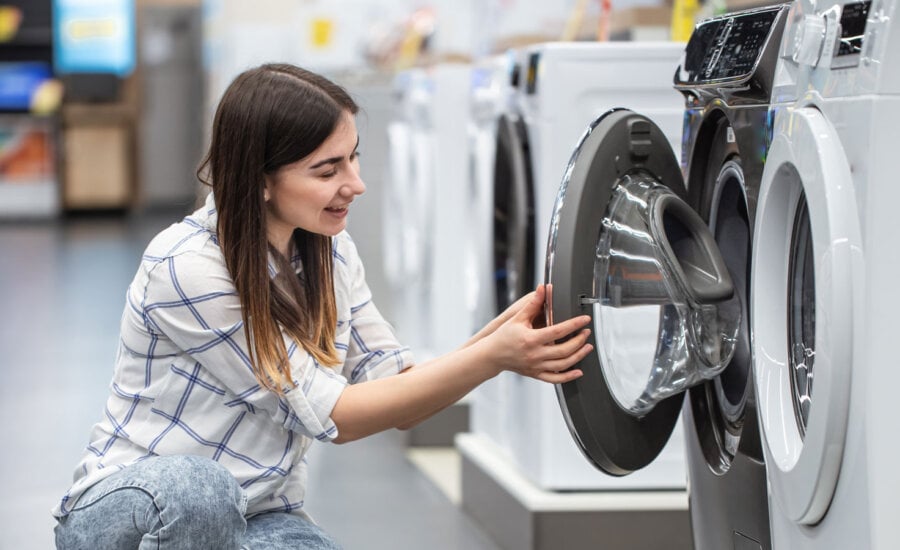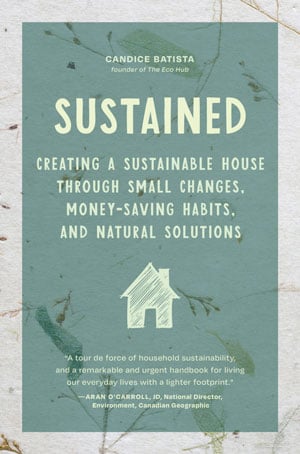How to buy the best washing machine and dryer to save money and the environment
In her new book, Candice Batista reveals the best ways to live a sustainable lifestyle—and save money. Here are her tips for buying a washer and dryer.
Advertisement
In her new book, Candice Batista reveals the best ways to live a sustainable lifestyle—and save money. Here are her tips for buying a washer and dryer.

Sometimes saving money and helping the environment go hand-in-hand, usually because of less waste and less costs in production. When it comes to buying a washing machine and a dryer, going the eco root can also help your wallet. Candice Batista explains how in this excerpt from her new book Sustained: Creating a Sustainable House Through Small Changes, Money-Saving Habits, and Natural Solutions (Mango Publishing Group, February 2024), available at amazon.ca and Chapters Indigo.

Drying your clothes also consumes a lot of energy, with dryers often using five to 10 times more power than washing machines. However, newer technologies are helping reduce this impact. For instance, heat-pump dryers recycle hot air, making them more energy efficient.
Saving energy and water by switching to a sustainable washing machine is a win for the environment and your pocketbook. This is because 90% of all energy used to wash your clothes comes from just waiting for the water to heat up. With the average household doing almost three hundred loads of laundry a year, this is where energy-efficiency washers (with cold-water settings, smaller drums and shorter cycles) can make a huge difference.
While eco-friendly washing machines can sometimes be more expensive, you will save money in the long run. If you buy a high-quality one, it should last seven to 10 years. That is a lot of years to cut down your energy and water bills.
Lastly, eco-friendly machines are generally much quieter and gentler on your clothes. Traditional washers are loaded from the top and use an agitator to free dirt and oils. While effective, agitators can be noisy and rough on delicate fabrics. Most eco-friendly models are front-loading washers since they use about 45% less energy and 50% less water.
This one might seem slightly obvious, but the energy and water usage of different washing machines marketed as “eco-friendly” vary. This is why making an informed purchase and researching is essential before buying.
Energy Star will be your best friend here since Energy Star–certified washers use less water and energy to run. They do this by identifying the integrated modified energy factor (IMEF) and integrated water factor (IWF) of a model. IMEF measures the energy used to run the spin cycle and heat the water.
While IWF estimates the gallons of water consumed per cubic foot of drum capacity. A water-efficient washing machine will have a low IWF, while an energy-efficient model will have a higher IMEF. The Energy Star homepage has an easy selection process where you can filter out different brands, price ranges and more. You can also check the yellow EnergyGuide label to estimate the model’s energy use and compare it to similar models.
A secondhand washing machine? Yep! Buying a model that is energy efficient and secondhand gives you the power and water-saving benefits down the road, but you are also offsetting the footprint you would have gained from manufacturing and transporting a new machine.
As always, you want to be on the lookout for greenwashing companies and have the certifications to back up their eco-friendly claims (this goes for dryers, too, by the way). When buying an eco-friendly washer and dryer, consider certifications like Energy Star. AAFA-certified washers also use steam to remove bacteria and dust mites from your clothing; this can be an excellent alternative for anyone with allergies and sensitivities to the toxins in laundry detergent.
I always check the reviews before I buy anything these days. And when doing so, you must consider what is important to you. For example, when reviewing reviews of front-load washers (most eco-friendly washers are front-load), one of the most common complaints is that they tend to develop mildew and a smell faster than top-load agitator washers. While annoying, you can always use a green cleaner to clean your front-load washer and combat smells.
Be on the lookout if the company you buy from has transparent reporting for their scope 1, 2, and 3 emissions. LG and Samsung are two examples of companies that sell efficient washing machines and are also on the reputable side for reporting carbon emissions.
Every eco-washing machine has a different width and drum capacity; larger drums use more water and energy with each load. If you have a large family and do laundry quite often, you might opt for a larger size. But stick to a smaller size if you are just one person, and you must fill up your washer to the top before running it.
As I mentioned, a considerable portion of washing machines’ environmental impact comes from the unit’s manufacturing and delivery. Remember, the second R in the nine Rs of Zero Waste is “refuse.” [The other eight include: rethink, reduce, reuse, renew, recycle, responsibility, replant and restore.] This means that even if you buy a new efficient washing machine, the energy and water savings you will gain might not make up for the emissions produced to get it to your home in the first place. So, with that in mind, only buy a new machine if your old one is beyond repair.
I recommend checking out the manufacturer’s repair and warranty policies before you purchase an eco-washing machine. From an environmental standpoint, repairing something broken is always better than buying new ones! For context, a good-quality washing machine should last between seven and 10 years.
When shopping for an eco-friendly dryer, remember that 88 million dryers in the U.S. alone emit over a ton of carbon dioxide annually, equivalent to approximately the emissions produced by driving a car for around 4,800 miles.
Here are some things to consider:
Let’s chat about the best practices for using your dryer. I know this might sound radical, but one surefire way to be super energy efficient is not to use your dryer. It’s true. It’s like energy efficiency on steroids.
Now, let’s address the lint filter situation. After every load, give that trusty lint filter a good cleaning. Don’t let it get clogged up like a traffic jam during rush hour. When the air circulation is blocked, your dryer’s energy efficiency takes a nosedive. Plus, it’s a crucial home safety measure. We don’t want any lint-related mishaps, do we?
Here’s a nifty feature for dryer shopping: a moisture sensor option. The cool kids on the block, a.k.a. newer dryers, come with this magic feature. It’s like having a mind-reading superhero in your laundry room. It automatically shuts off the dryer when your clothes are dry, saving energy and sparing you from unnecessary wear and tear. It’s a win-win situation.
Speaking of loads, find that sweet spot between “too full” and “barely there.” You want enough clothes for a full load without blocking the air circulation. And here’s a pro tip: avoid mixing wet clothes with partially dry ones. That’s like throwing a wrench into the drying process and increasing the drying time.
When it’s time to play wardrobe matchmaker in your dryer, sort your loads by the thickness of your clothes. Then, lightweights can have their little party in one quick load while the heavy hitters get their gig. It’s all about creating a harmonious drying experience for each fabric type.
Here’s a little secret: run your loads back to back. Why waste all that hot dryer goodness? Instead, take advantage of the already-toasty machine and immediately throw in your next load. Efficiency at its finest, my friend!
Even the simple act of doing laundry can make a difference regarding sustainability. Sustained living means finding enduring and balanced ways to carry out our daily activities while considering the environmental impact. Sustainable laundry practices all contribute to the long-term well-being of our ecosystems.
Excerpted from Sustained: Creating a Sustainable House Through Small Changes, Money-Saving Habits, and Natural Solutions by Candice Batista. (Copyright 2024 by Mango Publishing Group, February 2024) It is available at amazon.ca and Chapters Indigo.) Batista also the the founder and editor in chief of the website The Eco Hub.
Share this article Share on Facebook Share on Twitter Share on Linkedin Share on Reddit Share on Email